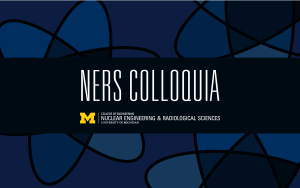Presented By: Nuclear Engineering & Radiological Sciences
NERS Colloquia Series: High-Resolution Multiphysics for Nuclear Engineering
April Novak, Argonne National Laboratory

Abstract:
Nuclear reactors represent tightly-coupled physics interactions between thermal-hydraulics, neutronics, material performance, structural mechanics, chemistry, and more. Multiphysics modeling is the practice of accounting for these physics interactions during design and analysis. Recent advancements in high performance computing now enable multiphysics simulations with state-of-the-art Monte Carlo neutron transport and Computational Fluid Dynamics (CFD) tools. This talk will begin with a high-level overview of the most important coupled physics interactions in fission reactors, and then introduce the theory of multiphysics modeling as most commonly applied in nuclear engineering. Current research in Monte Carlo-based multiphysics applications will be summarized in terms of acceleration strategies, stability, field mapping, and software development. Then, multiphysics methods research at Argonne National Laboratory using high-resolution CFD and Monte Carlo tools will be presented through the lens of prismatic high temperature gas reactors. Finally, student opportunities at Argonne National Laboratory for both undergraduate and graduate students will be introduced.
Bio:
Dr. April Novak is the Maria Goeppert-Mayer Fellow in the Computational Sciences Division of Argonne National Laboratory, where she conducts research in multiphysics modeling and simulation, computational thermal-hydraulics, and multiscale methods. April is the lead developer of the Cardinal application, an open-source software tool that couples the NekRS Computational Fluid Dynamics (CFD) and OpenMC Monte Carlo codes to the MOOSE framework. As part of her PhD research, April developed multiscale methods for pebble bed analysis within the coarse-mesh thermal-fluid Pronghorn MOOSE application. She now leads several projects in the high-resolution multiphysics space with applications to fast reactor core radial expansion and gas microreactors, and supports a broad range of nuclear industry collaborations. She has a PhD in nuclear engineering from the University of California, Berkeley (2020) and a B.S. in nuclear engineering from the University of Illinois, Urbana-Champaign (2015).
Nuclear reactors represent tightly-coupled physics interactions between thermal-hydraulics, neutronics, material performance, structural mechanics, chemistry, and more. Multiphysics modeling is the practice of accounting for these physics interactions during design and analysis. Recent advancements in high performance computing now enable multiphysics simulations with state-of-the-art Monte Carlo neutron transport and Computational Fluid Dynamics (CFD) tools. This talk will begin with a high-level overview of the most important coupled physics interactions in fission reactors, and then introduce the theory of multiphysics modeling as most commonly applied in nuclear engineering. Current research in Monte Carlo-based multiphysics applications will be summarized in terms of acceleration strategies, stability, field mapping, and software development. Then, multiphysics methods research at Argonne National Laboratory using high-resolution CFD and Monte Carlo tools will be presented through the lens of prismatic high temperature gas reactors. Finally, student opportunities at Argonne National Laboratory for both undergraduate and graduate students will be introduced.
Bio:
Dr. April Novak is the Maria Goeppert-Mayer Fellow in the Computational Sciences Division of Argonne National Laboratory, where she conducts research in multiphysics modeling and simulation, computational thermal-hydraulics, and multiscale methods. April is the lead developer of the Cardinal application, an open-source software tool that couples the NekRS Computational Fluid Dynamics (CFD) and OpenMC Monte Carlo codes to the MOOSE framework. As part of her PhD research, April developed multiscale methods for pebble bed analysis within the coarse-mesh thermal-fluid Pronghorn MOOSE application. She now leads several projects in the high-resolution multiphysics space with applications to fast reactor core radial expansion and gas microreactors, and supports a broad range of nuclear industry collaborations. She has a PhD in nuclear engineering from the University of California, Berkeley (2020) and a B.S. in nuclear engineering from the University of Illinois, Urbana-Champaign (2015).